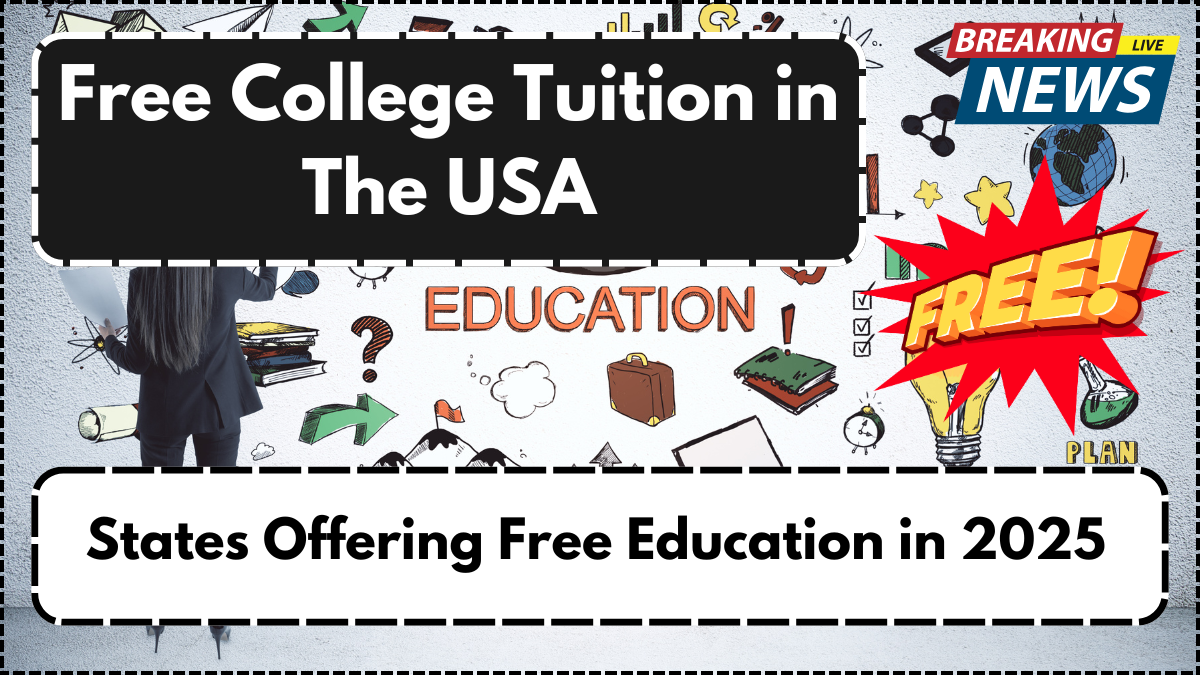As of May 2025, more U.S. states are investing in free college tuition programs, expanding access to higher education for eligible residents. With student debt reaching record levels, many state governments are responding with education aid 2025 packages designed to make two- and four-year college degrees more accessible. These initiatives vary by state but often target recent high school graduates, low- to middle-income families, and career-specific training paths.

States Offering Free Tuition in 2025
Free college tuition programs USA 2025 are no longer isolated experiments. Multiple states have adopted or expanded their own models. Here’s a snapshot of where students can now attend public colleges tuition-free, provided they meet certain criteria:
State | Program Name | Eligibility Highlights | Type of Institution Covered |
|---|---|---|---|
New York | Excelsior Scholarship | Income below $125,000, full-time enrollment | SUNY and CUNY colleges |
California | California College Promise | First-time students, full-time at community colleges | Community Colleges |
Tennessee | Tennessee Promise | High school graduates, mentoring program participation | Community and Technical Colleges |
Oregon | Oregon Promise | Recent graduates, income cap applies | Community Colleges |
New Mexico | Opportunity Scholarship | No income cap, all ages eligible | Public Colleges and Universities |
Michigan | Michigan Reconnect | Adults 25+, no prior degree | Community Colleges |
Minnesota | North Star Promise | Families earning under $80,000 | Public Institutions (2 & 4-year) |
What’s New in Education Aid 2025?
The education aid 2025 landscape includes not just tuition waivers, but also expanded access to textbooks, transportation support, and academic advising. States are adjusting their programs based on economic recovery trends, population needs, and labor market demands. For instance, Minnesota’s new North Star Promise includes extra support for students in high-demand sectors like healthcare and IT.
Another trend gaining momentum is the inclusion of adult learners in these programs. Michigan Reconnect and New Mexico’s Opportunity Scholarship now allow older adults to earn their first degree tuition-free, addressing the upskilling gap in the workforce.
Key Differences Among State Tuition Offers
While the idea of free college is universal, the implementation varies widely. Some state tuition offers are “last-dollar” programs—meaning they cover remaining tuition after other financial aid is applied—while others are “first-dollar,” allowing students to retain additional scholarships for other expenses.
Program duration also varies. California’s Promise covers only the first two years, while New York’s Excelsior continues through a four-year degree. Income eligibility thresholds, GPA requirements, and service commitments (like community service or in-state residency post-graduation) differ across the board.
How to Apply for Free Tuition in 2025
Application processes are typically linked to the FAFSA, which must be submitted annually. States then determine eligibility based on income, academic status, and residency. Many states require full-time enrollment, though exceptions exist for adult learners. Deadlines differ, so checking the individual program website is essential. Students are also encouraged to meet with high school counselors or college advisors early.
Is Free College the Future in the USA?
With bipartisan support in many legislatures and growing public demand, the momentum behind free college tuition programs USA 2025 shows no signs of slowing. These state-driven efforts are filling gaps in federal aid and setting models for national adoption. If the success of New Mexico’s and Tennessee’s programs is any indicator, more states may join the movement by 2026.
Conclusion
Free college tuition in the USA is becoming more than a concept—it’s a reality for students across multiple states in 2025. From high school graduates to adult learners, education aid 2025 has widened access to career training and degrees, without the lifelong burden of debt. By understanding state tuition offers and staying proactive about deadlines and eligibility, students can take full advantage of these transformative programs.
FAQ
What is a “last-dollar” scholarship?
A last-dollar scholarship covers tuition costs that remain after applying other forms of financial aid like Pell Grants.
Are these programs only for recent high school graduates?
Not always. States like Michigan and New Mexico now include adult learners in their tuition-free initiatives.
Can I use free tuition programs to attend a private college?
Generally no. Most programs apply only to public institutions, though a few exceptions exist for specific in-state private colleges under partnership models.
Is housing included in free tuition programs?
Usually not. These programs mostly cover tuition and sometimes fees, not room and board.
Will more states offer free tuition in 2026?
It’s likely. Given current trends and political support, more states are expected to introduce or expand free college initiatives in the coming year.
Click here to learn more